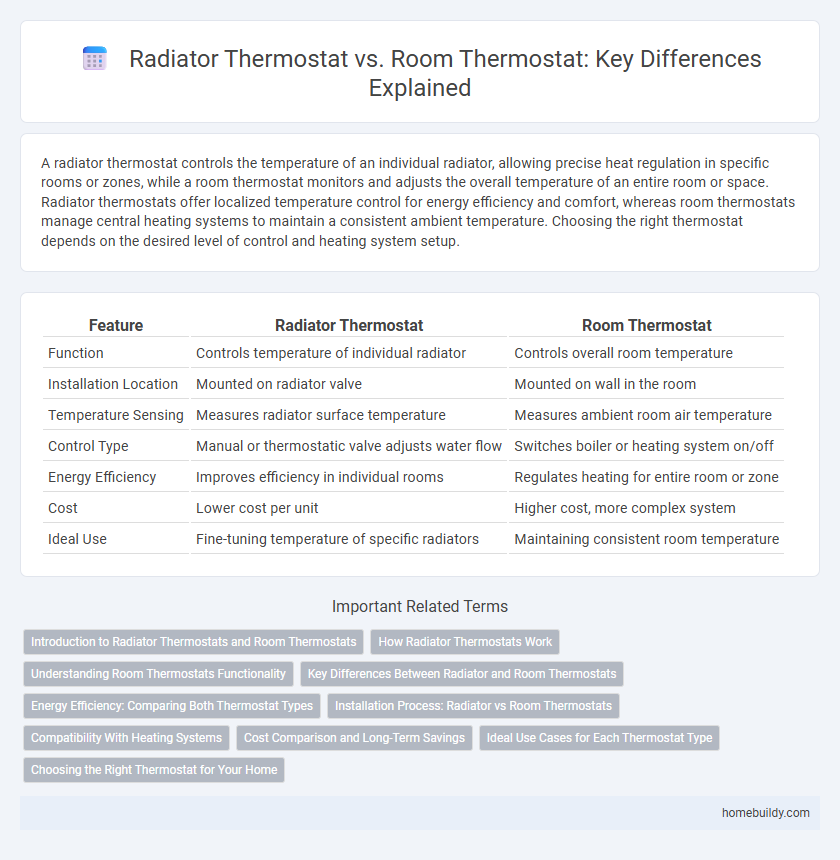A radiator thermostat controls the temperature of an individual radiator, allowing precise heat regulation in specific rooms or zones, while a room thermostat monitors and adjusts the overall temperature of an entire room or space. Radiator thermostats offer localized temperature control for energy efficiency and comfort, whereas room thermostats manage central heating systems to maintain a consistent ambient temperature. Choosing the right thermostat depends on the desired level of control and heating system setup.
Table of Comparison
| Feature | Radiator Thermostat | Room Thermostat |
|---|---|---|
| Function | Controls temperature of individual radiator | Controls overall room temperature |
| Installation Location | Mounted on radiator valve | Mounted on wall in the room |
| Temperature Sensing | Measures radiator surface temperature | Measures ambient room air temperature |
| Control Type | Manual or thermostatic valve adjusts water flow | Switches boiler or heating system on/off |
| Energy Efficiency | Improves efficiency in individual rooms | Regulates heating for entire room or zone |
| Cost | Lower cost per unit | Higher cost, more complex system |
| Ideal Use | Fine-tuning temperature of specific radiators | Maintaining consistent room temperature |
Introduction to Radiator Thermostats and Room Thermostats
Radiator thermostats regulate the temperature of individual radiators by controlling the flow of hot water, offering precise room-by-room heating management. Room thermostats monitor the overall temperature of a space and control the central heating system to maintain a consistent ambient temperature. Understanding the difference enhances energy efficiency and comfort by optimizing heating control at both the radiator and whole-room levels.
How Radiator Thermostats Work
Radiator thermostats regulate heat by sensing the air temperature around the radiator and adjusting the valve to control hot water flow, maintaining a consistent room temperature. Unlike room thermostats, which measure overall room temperature and control the boiler, radiator thermostats provide localized temperature control for individual rooms or zones. This precise adjustment helps optimize energy efficiency and comfort by preventing overheating in specific areas.
Understanding Room Thermostats Functionality
Room thermostats regulate the overall temperature of a space by controlling the heating system based on preset temperature settings, ensuring consistent comfort throughout the room. Unlike radiator thermostats that adjust heat output at individual radiators, room thermostats communicate with the boiler to switch the entire heating system on or off. This centralized control optimizes energy efficiency by preventing overheating and maintaining stable indoor temperatures.
Key Differences Between Radiator and Room Thermostats
Radiator thermostats control the temperature of individual radiators by regulating the flow of hot water based on the room's immediate heat, providing localized comfort and energy efficiency. Room thermostats monitor the overall room temperature and adjust the central heating system to maintain a consistent ambient heat throughout the entire space. While radiator thermostats offer precise control at each heating unit, room thermostats manage the heating system collectively for broad temperature regulation.
Energy Efficiency: Comparing Both Thermostat Types
Radiator thermostats regulate individual radiator temperatures, allowing precise control over heat output in each room, which enhances energy efficiency by preventing overheating. Room thermostats monitor the ambient temperature of the entire space and control the central heating system, ensuring consistent warmth but potentially leading to energy waste if rooms are unoccupied. Combining both types optimizes energy use by adjusting heat distribution based on room occupancy and overall indoor temperature.
Installation Process: Radiator vs Room Thermostats
Radiator thermostats are typically installed directly on the radiator valve, allowing individual control of each radiator's temperature and requiring minimal plumbing adjustments. Room thermostats, in contrast, are wall-mounted devices that monitor ambient room temperature and control the entire heating system, often necessitating wiring to the central heating unit. The installation of radiator thermostats is generally simpler and more cost-effective, while room thermostats require professional electrical work and integration with the heating system's controls.
Compatibility With Heating Systems
Radiator thermostats control the temperature of individual radiators by adjusting the flow of hot water, making them compatible with most central heating systems including combi boilers, system boilers, and conventional systems. Room thermostats regulate the overall temperature of the entire home by communicating with the heating system's boiler or furnace, requiring integration with systems that support zone control or central heating. Compatibility depends on the heating system type and control technology, where radiator thermostats offer localized temperature control, while room thermostats manage global home heating settings.
Cost Comparison and Long-Term Savings
Radiator thermostats typically have a lower upfront cost compared to room thermostats but may result in higher energy bills due to less precise temperature control. Room thermostats offer better efficiency by regulating the entire heating system, which can lead to significant long-term savings on energy costs. Investing in a room thermostat often balances initial expenses with improved energy management, reducing overall household heating expenses over time.
Ideal Use Cases for Each Thermostat Type
Radiator thermostats are ideal for controlling individual room temperatures by regulating heat output directly at the radiator, making them perfect for rooms with varying heating needs or occupancy patterns. Room thermostats measure ambient temperature and control the entire heating system, offering efficient energy management in homes with uniform heating requirements or centralized systems. Choosing between a radiator thermostat and a room thermostat depends on whether precise, localized control or broader, system-wide regulation is desired.
Choosing the Right Thermostat for Your Home
Radiator thermostats regulate the temperature by controlling individual radiators, providing room-specific heat adjustments and improving energy efficiency in multi-room setups. Room thermostats monitor the overall ambient temperature and manage the entire heating system, ensuring balanced warmth throughout the home. Selecting the right thermostat depends on your heating needs, with radiator thermostats ideal for personalized comfort and room thermostats suited for centralized temperature control.
Radiator Thermostat vs Room Thermostat Infographic

 homebuildy.com
homebuildy.com